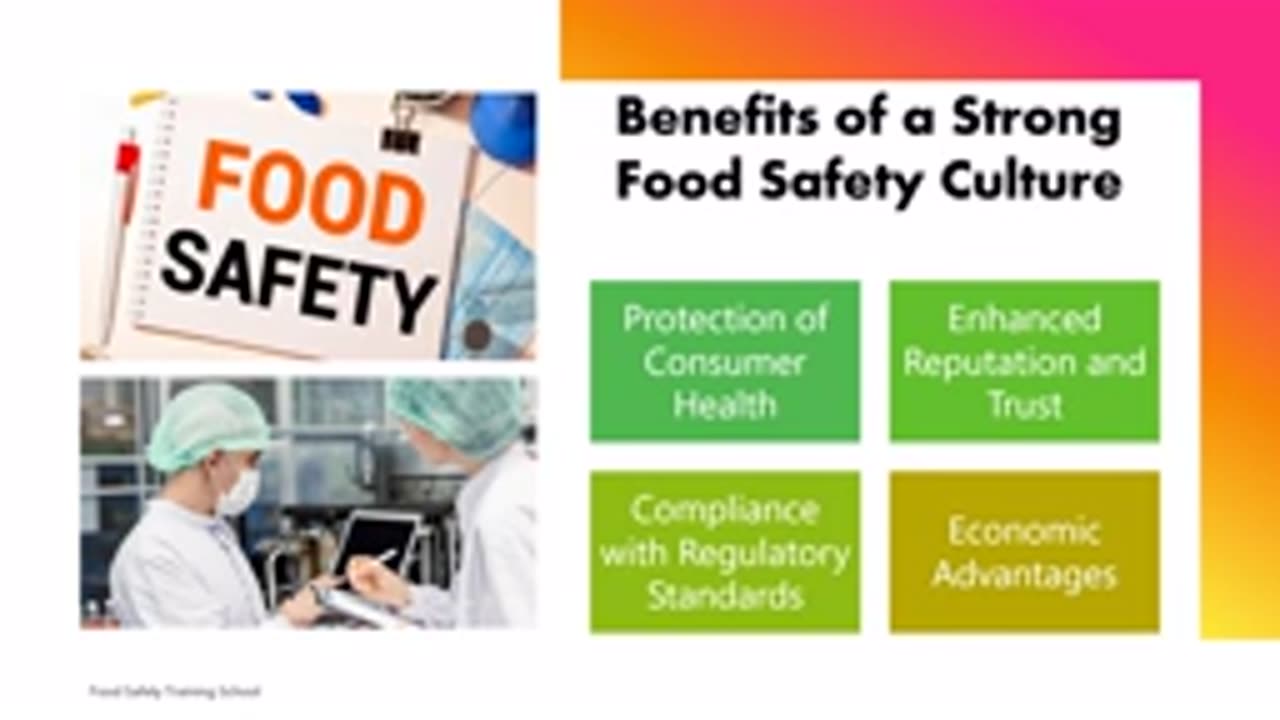Premium Only Content

Food Safety Culture │ Food Safety
### **Food Safety Culture**
**Food safety culture** refers to the shared values, beliefs, attitudes, and practices within an organization that influence food safety behaviors and decisions. It encompasses everything from employee awareness and training to the company's commitment to maintaining food safety standards. A strong food safety culture is essential in preventing foodborne illnesses, ensuring compliance with regulations, and maintaining the reputation of a food business.
---
### **Why Food Safety Culture Matters**
- **Prevention of Foodborne Illnesses:** A strong food safety culture reduces the risk of contamination, outbreaks, and recalls.
- **Employee Engagement:** Employees are more likely to follow food safety protocols when they understand their importance and feel supported by the organization.
- **Regulatory Compliance:** A company with a strong food safety culture is more likely to meet local and international food safety regulations.
- **Brand Reputation:** Businesses known for maintaining high food safety standards gain customer trust and loyalty.
---
### **Key Elements of Food Safety Culture**
1. **Leadership Commitment**
- **Description:** Leadership must set the tone for food safety by demonstrating a commitment to it at all levels. Leaders should lead by example and make food safety a priority in all business decisions.
- **Example:** Senior management should actively support training programs, ensure resources are available for food safety practices, and prioritize food safety in business planning.
2. **Employee Involvement**
- **Description:** A food safety culture thrives when all employees are involved and committed to maintaining safety practices. Employees should feel empowered to report issues and suggest improvements.
- **Example:** Regular feedback loops, open communication, and a non-punitive reporting system encourage staff to stay vigilant and engaged.
3. **Training and Education**
- **Description:** Ongoing training and education are crucial to maintaining a strong food safety culture. Employees must be equipped with the knowledge and skills to follow best practices and recognize potential food safety hazards.
- **Example:** Routine food safety training sessions, role-playing scenarios, and access to updated safety resources help employees stay informed.
4. **Clear Policies and Procedures**
- **Description:** Well-defined food safety policies and procedures guide employees in their daily tasks. Clear expectations should be set, and these procedures must be regularly reviewed and updated.
- **Example:** Detailed standard operating procedures (SOPs) for handling food, sanitation, and allergen management should be easily accessible and followed by all staff.
5. **Communication**
- **Description:** Effective communication is a cornerstone of food safety culture. Open and transparent communication helps prevent misunderstandings and promotes a collaborative environment.
- **Example:** Use of safety meetings, newsletters, and visible signage to keep food safety top of mind for employees.
6. **Accountability and Responsibility**
- **Description:** Everyone in the organization should be held accountable for food safety practices, with designated individuals responsible for monitoring and enforcing standards.
- **Example:** Supervisors conducting regular food safety checks, and employees being held accountable for following hygiene protocols.
7. **Continuous Improvement**
- **Description:** A strong food safety culture involves a commitment to continuous improvement. Regular audits, assessments, and feedback mechanisms help identify weaknesses and improve food safety practices over time.
- **Example:** Implementing corrective actions based on audit findings and taking proactive steps to prevent recurring issues.
8. **Monitoring and Performance Measurement**
- **Description:** Regular monitoring of food safety practices and the effectiveness of training is essential. Metrics can help track progress and identify areas for improvement.
- **Example:** Tracking incidents, non-conformities, or employee participation in food safety programs to measure the culture's effectiveness.
---
### **Building and Sustaining Food Safety Culture**
1. **Start with Strong Leadership**
- Leaders must create and communicate a clear vision for food safety, demonstrate their commitment, and allocate resources for safety initiatives. Leading by example is crucial in inspiring employees to take food safety seriously.
2. **Engage Employees**
- Foster an environment where employees feel responsible for food safety. Encourage active participation through regular training, open forums for questions, and feedback sessions. A culture of mutual respect and trust helps employees feel comfortable speaking up about safety concerns.
3. **Regularly Assess the Food Safety Culture**
- Conduct regular assessments and surveys to understand the organization’s food safety culture. This helps identify potential gaps and areas for improvement, ensuring that food safety is continuously prioritized.
4. **Reward Safe Practices**
- Acknowledge and reward employees who consistently follow food safety practices. Recognition, whether formal or informal, reinforces the importance of food safety and motivates others to adopt safe practices.
5. **Create a Supportive Environment**
- Develop an environment where food safety is seen as everyone’s responsibility. Encourage teamwork, provide necessary tools and equipment, and create a system that promotes safe behavior.
---
### **Measuring Food Safety Culture**
Organizations can assess their food safety culture using various tools and methods:
- **Surveys and questionnaires** to gauge employee knowledge and attitudes about food safety.
- **Audits and inspections** to evaluate the adherence to safety standards and procedures.
- **Incident tracking** to monitor the occurrence of food safety issues and near-misses.
---
### **The Benefits of a Strong Food Safety Culture**
- **Reduced Risk of Foodborne Illnesses:** A proactive culture helps prevent contamination and ensures products are safe for consumption.
- **Regulatory Compliance:** A strong food safety culture makes it easier to comply with food safety regulations, reducing the risk of fines, recalls, and lawsuits.
- **Improved Operational Efficiency:** Effective food safety practices lead to fewer errors, reduced waste, and more streamlined processes.
- **Enhanced Brand Loyalty and Consumer Trust:** A commitment to food safety builds consumer confidence, contributing to long-term business success.
---
### **Conclusion**
A strong food safety culture is foundational to ensuring that food is handled, stored, and prepared in a way that minimizes risks to consumers. By committing to leadership, employee involvement, clear policies, and continuous improvement, businesses can create a culture where food safety is ingrained in everyday practices, helping to prevent contamination and protect public health.
-
 1:01:17
1:01:17
The StoneZONE with Roger Stone
6 hours agoChristmas Edition: Why the Panama Canal is Part of the America First Agenda | The StoneZONE
40.4K19 -
 LIVE
LIVE
LFA TV
17 hours agoLFA TV CHRISTMAS EVE REPLAY
652 watching -
 LIVE
LIVE
tacetmort3m
1 day ago🔴 LIVE - THE ZONE KEEPS PULLING ME BACK - STALKER 2 - PART 15
905 watching -
 22:45
22:45
Brewzle
14 hours agoI Went Drinking In A Real Bourbon Castle
25.9K3 -
 48:36
48:36
PMG
1 day ago $1.87 earned"Parkland Parent Speaks Out On Kamala Harris Using Victims"
19.2K3 -
 4:06
4:06
The Lou Holtz Show
12 hours agoCoach Lou Holtz’s Heartfelt Christmas Message 🎄 | Family, Faith & Notre Dame Spirit 💚 #christmas
14.5K -
![ROSEANNE BARR - Her Journey, TRUMP, and the MAGA GOLDEN AGE! [INTERVIEW]](https://1a-1791.com/video/s8/1/M/m/B/2/MmB2v.0kob.1-small-ROSEANNE-BARR-Her-Journey-T.jpg) 51:35
51:35
Dr Steve Turley
1 day ago $17.95 earnedROSEANNE BARR - Her Journey, TRUMP, and the MAGA GOLDEN AGE! [INTERVIEW]
49.9K50 -
 57:38
57:38
The Tom Renz Show
10 hours agoMerry Christmas - The Tom Renz Show Christmas
87.8K16 -
 2:59:10
2:59:10
Wendy Bell Radio
21 hours agoThe Bridge Too Far
166K301 -
 1:03:45
1:03:45
Donald Trump Jr.
1 day agoHappy Festivus: Airing Our Grievances and Stopping The Swamp w/Sean Davis | TRIGGERED Ep.201
426K546